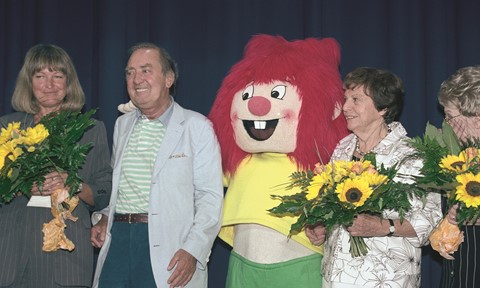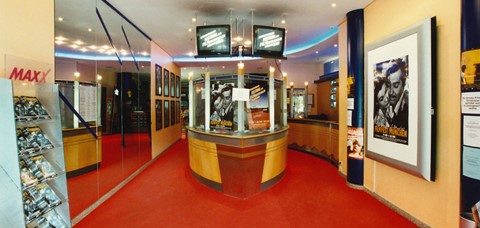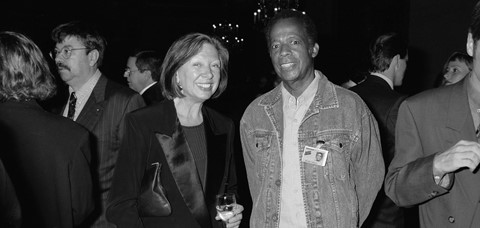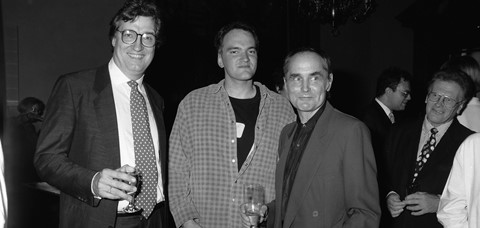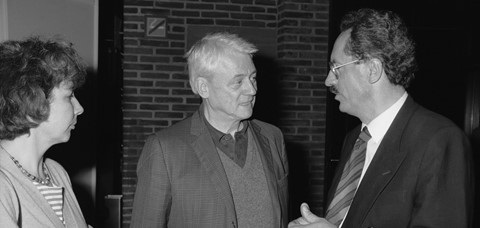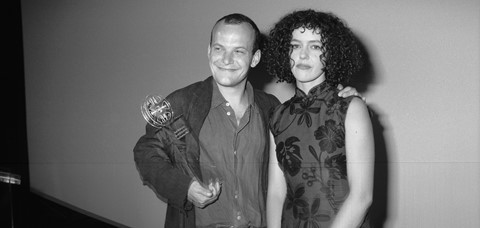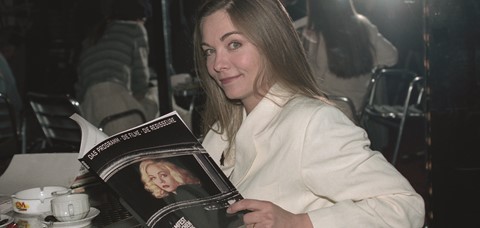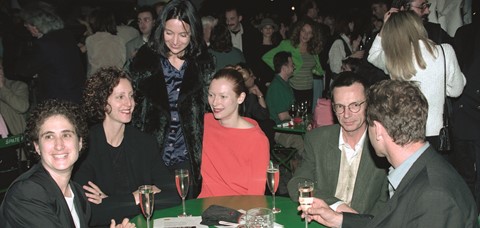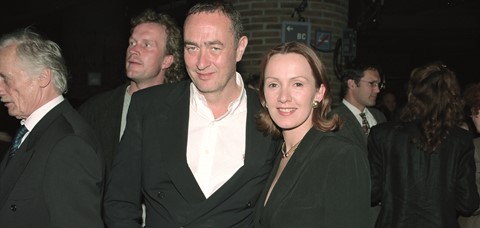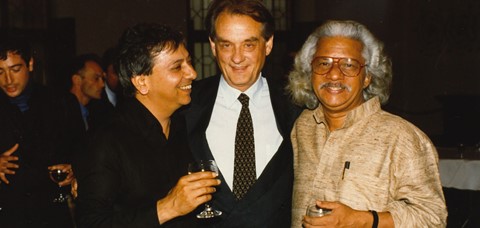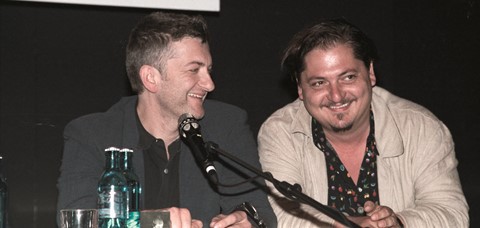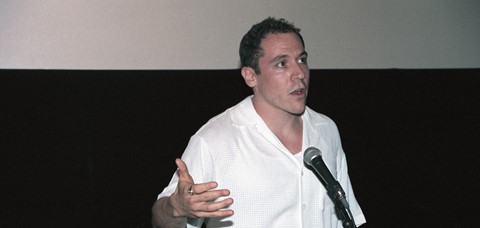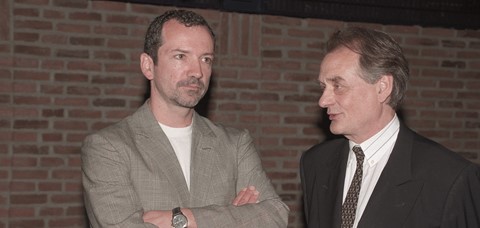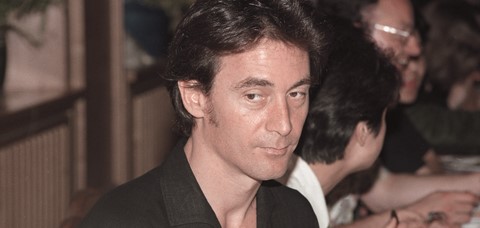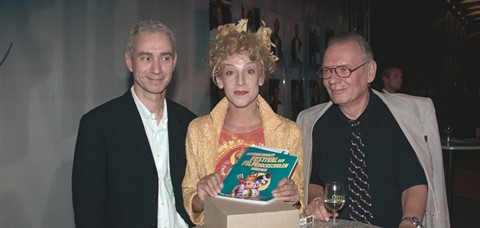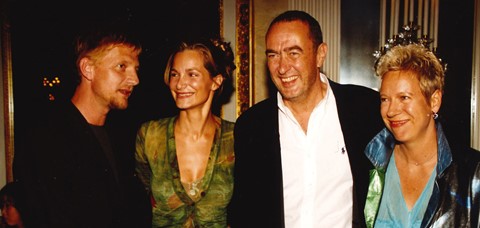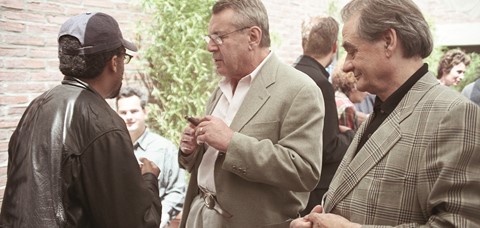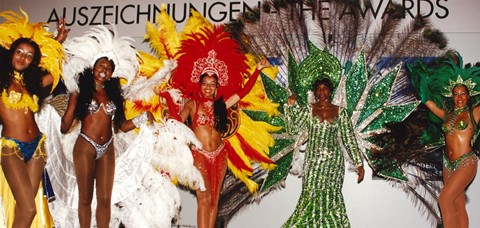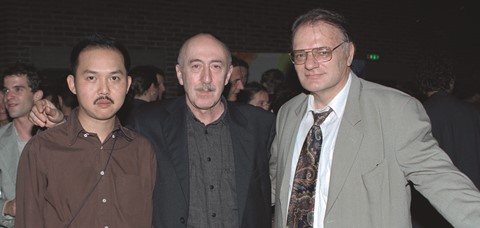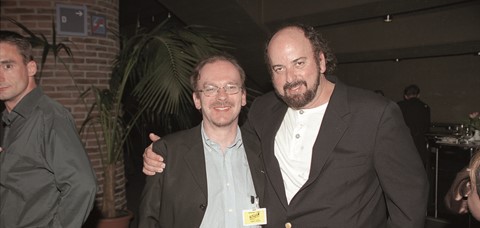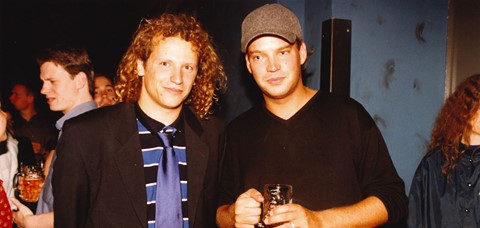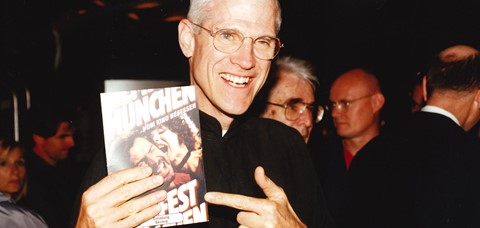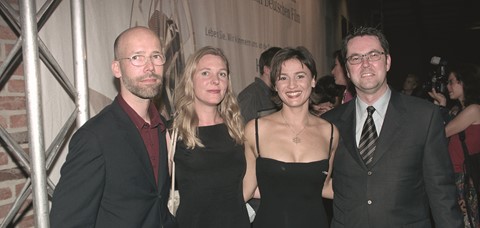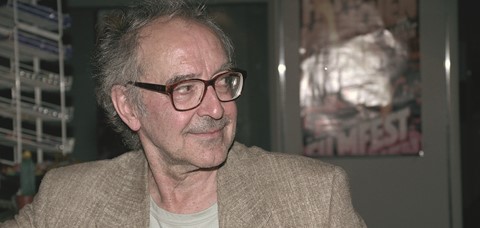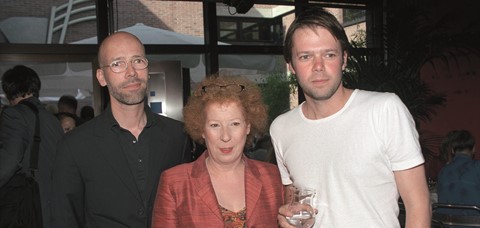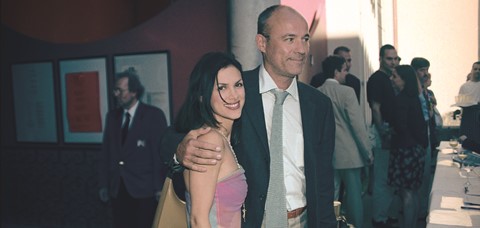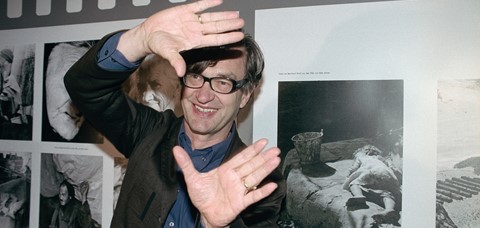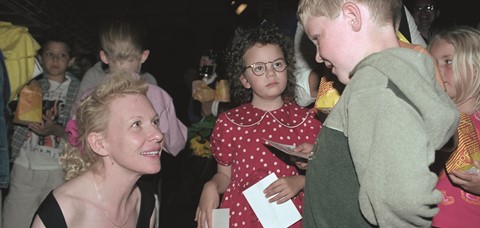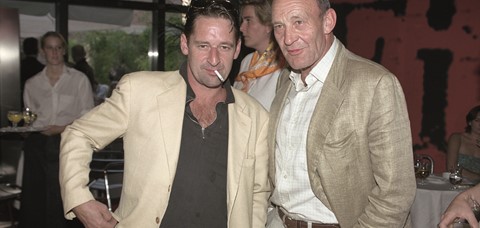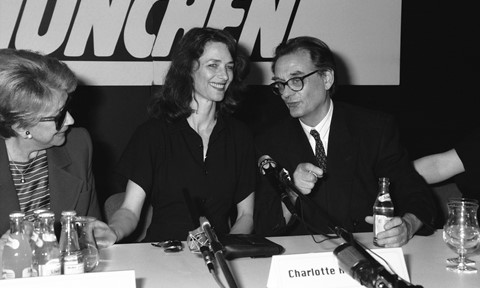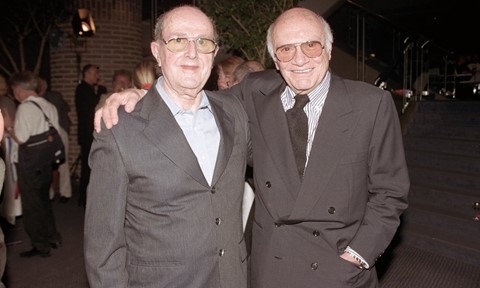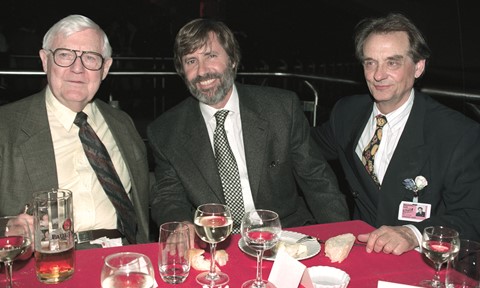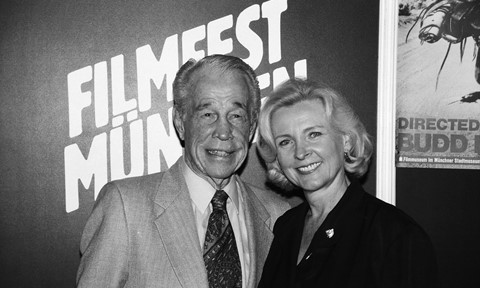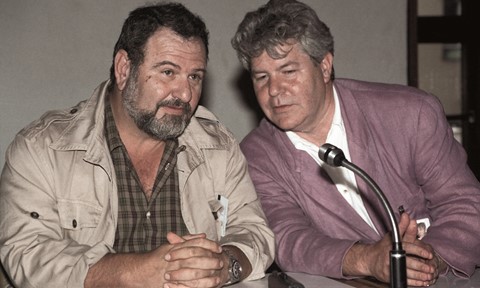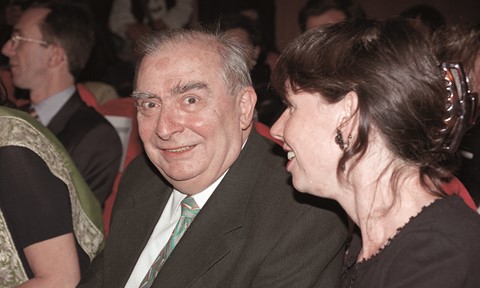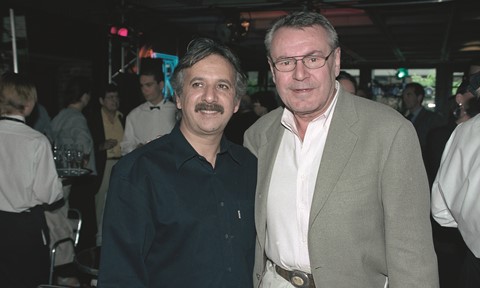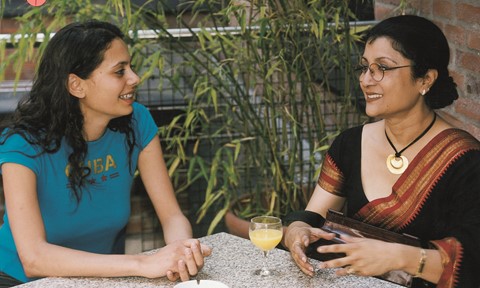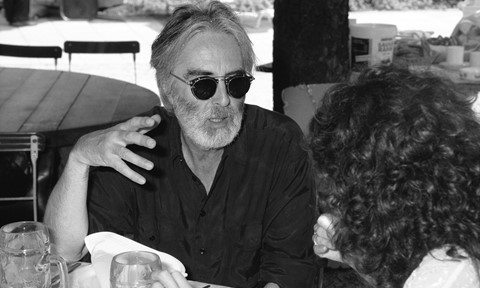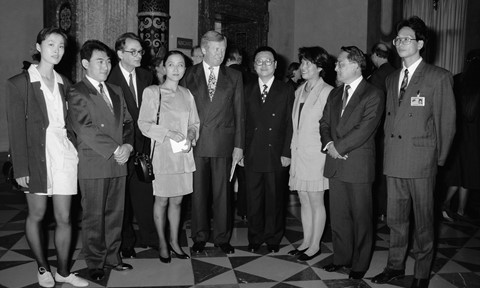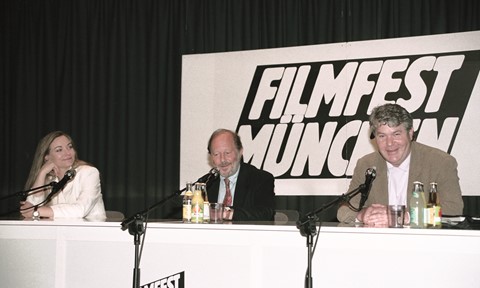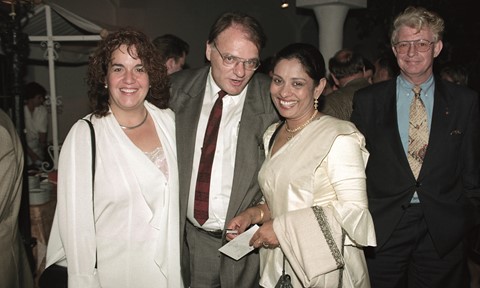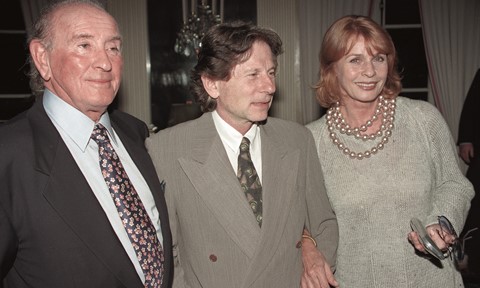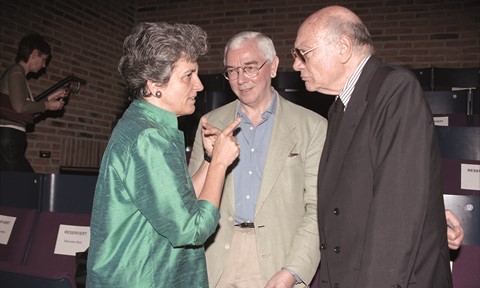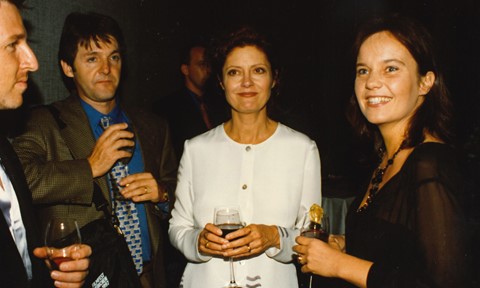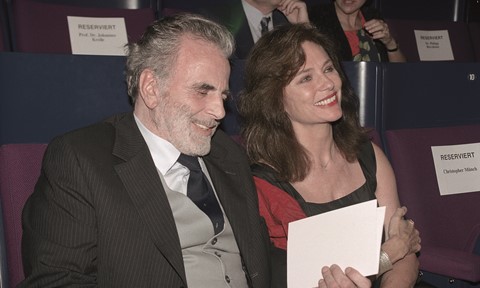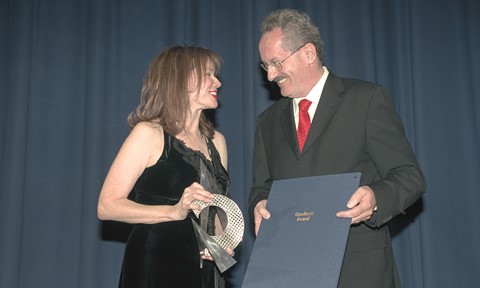1993-2002
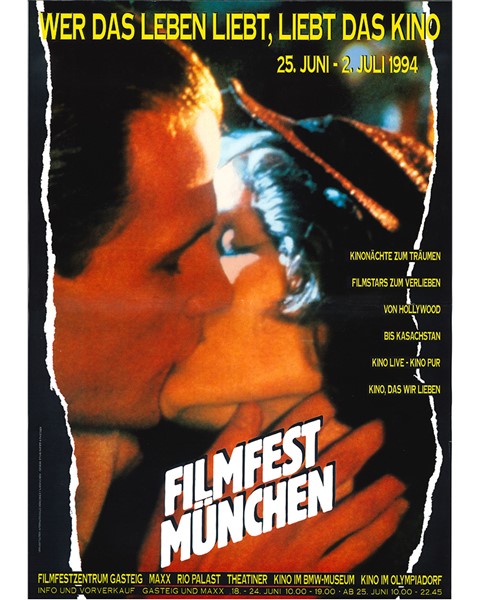
TO LOVE LIFE IS TO LOVE THE CINEMA
The second decade of the festival dawned in 1993, with Eberhard Hauff staying on as its director. Certain sections, such as American Independents and New German-Language Films, had become firmly established by this time, and were supplemented by focuses on works from other regions, particularly France and Latin America. In 1994, FILMFEST MÜNCHEN became one of the first festivals to introduce a section of new TV movies. The Director’s Promotional Award from the Hypo-Bank and the One Future Prize from the Interfilm Akademie were among the awards added. German and international stars came to Munich for retrospectives and homages; in 1997, the CineMerit Award was presented for the first time.
The team of curators working for Eberhard Hauff had become a well-oiled machine. Klaus Eder, Robert Fischer, and Uschi Reich were responsible for the International Program, Ulla Rapp for the American Independents, and Ulrich Maass for the German films. Hans and Christel Strobel were in charge of the Kinderfilmfest.
The team proved to be shrewd and creative when it came to finding common themes among the jumble of films they’d selected. In 1993, for example, the motto of the festival was “648 Hours of Love, Hate and Passion”. In the foreword to that year’s catalogue, Eberhard Hauff commented:
“What are we offering? A superb program of the conditio humana, a 648-hour-long journey to the origins and motives of love, hatred, and passion, which everyone can witness and take part in.”
In the foreword to the following year’s catalogue, Hauff proclaimed, “To Love Life Is to Love the Cinema”. The year after that, the motto, certainly with the best of intentions, was “The Beauty of Film Is the Women”. Beyond that, Hauff said, “Welcome to the Festival of Grand Emotions” (1997), spoke of “Magic Moments” (1998), found “Cinema Totally Ingenious” (1999), and was “Obsessed with Cinema” (2000). One could be certain that “The Pleasures of Perception” (2001) revealed “The Magic of Movies” (2002) to him. Somewhat surprising, however, was his “personal note” in the foreword to the 1996 catalogue: “As for myself, I prefer to watch movies all alone, just myself and the events on the screen. Although it may just be the quirk of a festival director, I find this the most intense way to experience a film.” But what did the headline say? “You are never alone at the movies.”
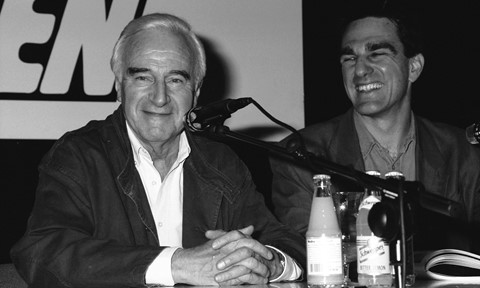
special guests
Munich puts on a wonderful festival. It’s amazing how full the theaters are in the middle of summer. I felt much more at home here than at Cannes or the other glitzy festivals. Munich offers pure cinema for the real audience.
Over the years, FILMFEST MÜNCHEN has welcomed a remarkable number of special guests. Those honored in various homages, tributes, and portraits included: British actress Charlotte Rampling (1993); Portuguese director Manoel de Oliveira (1995); screenwriter Ron Bass (1996), who received an Oscar for RAIN MAN; American directors Budd Boetticher (1995), Jules Dassin and John Milius (both 1997); French directors Claude Sautet (1993), Claude Chabrol (2000), and Jean-Pierre Jeunet (2001); and some big names in Asian film, including Anoja (1996), a star in her native Sri Lanka; Iranian director Majid Majidi (2000); and Indian filmmaker Aparna Sen (2002).
“Jean-Pierre Jeunet, whom the Filmfest is honoring with a portrait this year, celebrates the pleasures of perception with his latest work, LE FABULEUX DESTIN D’AMÉLIE POULAIN in a tantalizing way, confirming François Truffaut’s insight that cinema is at its best when it succeeds in outdoing reality. It shows us that deep down in every human being there is something unique and wonderful. What more can you ask of cinema?”
Eberhard Hauff in the 2001 catalogue
Each year, one or more retrospectives focused on works by individual screenwriters or directors or presented films from specific countries or continents. In 1993, several films of China’s “fifth generation” of filmmakers were shown, as well as of “Early Black Cinema”. These were followed by retrospectives of films by Nanni Moretti and Michael Haneke (1994), Nelson Pereira dos Santos and Nicolas Roeg (both 1995), Robert Wise (1996), Ann Hui (1997), Francesco Rosi (1998), Roman Polanski and Karel Zeman (1999), Miloš Forman (2000), and Matthias Müller and Ulf Stark (2002).
Starting in 1997, the CineMerit Award honored “outstanding personalities in international filmmaking for their achievements in the art of film”. There were two award-winners that year: Susan Sarandon and Jules Dassin. They were followed by producer Eric Pleskow and director Francesco Rosi (1998), producer Marin Karmitz (1999), director Miloš Forman (2000), actress Jacqueline Bisset and director Manoel de Oliveira (2001), and actress Barbara Hershey (2002).
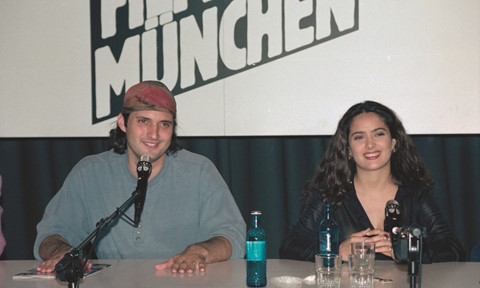
Robert Rodriguez and Salma Hayek
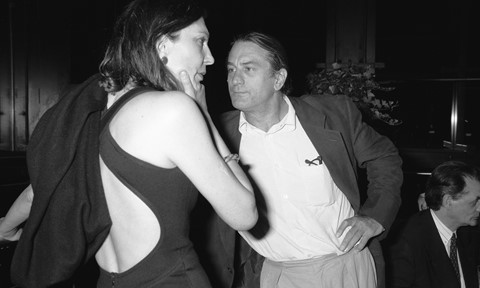
Robert De Niro
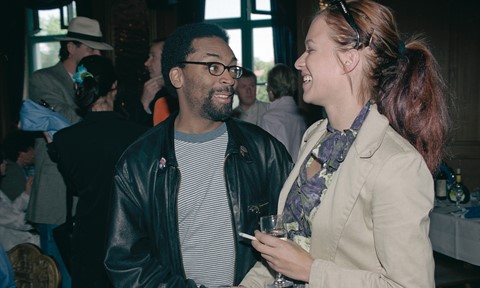
Spike Lee and franka potente
Sometimes the stars came to Munich to present their latest films without receiving any special tribute. After winning the Palme d’Or at Cannes in 1994, Quentin Tarantino stopped by with PULP FICTION. That same year, Robert De Niro was here, and his directorial debut, A BRONX TALE, was screened as the opening film. As part of the Previews section in 1996, FROM DUSK TILL DAWN was screened, with director Robert Rodriguez and actress Salma Hayek (the one dancing with the snake) showing up to the press conference in good spirits. Georgian director Otar Iosseliani presented his film MARABUS! in 1999. In 2000, SUMMER OF SAM was screened as part of the International Program, with director Spike Lee attending. Important visitors were in store for 2001 as well, when Jean-Luc Godard brought his film ÉLOGE DE L’AMOUR to the festival.
YOUNG EUROPEAN CINEMA
While the Filmfest featured the grand premieres of new works by established directors, it was also intended to promote the next generation of filmmakers. The International Festival of Film Schools was organized in 1981, two years before the first Filmfest, with Professor Wolfgang Längsfeld of the University of Television and Film Munich (HFF) as its director and “1st European Student Film Competition” as its title. For a few years, it was held in the summer at the same time as the Filmfest, but was later split off and moved to the somewhat colder month of November. The venue for this festival of young talent was first the HFF, then the Filmmuseum. In 2021, the festival returned to the HFF after many years.
Early on, the Filmfest had a section of new works by young European filmmakers, called Perspectives. Starting in 1993, “international discoveries” were made in the High Hopes section. In the foreword to the catalogue, Eberhard Hauff wrote:
“A new feature intended as a contrast is the ‘High Hopes’ sidebar with selected highlights of young cinema. A cinema which defines itself by its youthful commitment, contradiction, and new aesthetic concepts, a cinema of beginnings and high hopes. Extraordinary talents like Francesca Archibugi, Ildikó Szabó, Valery Pendrakovsky, and Philippe Muyl set the direction.”
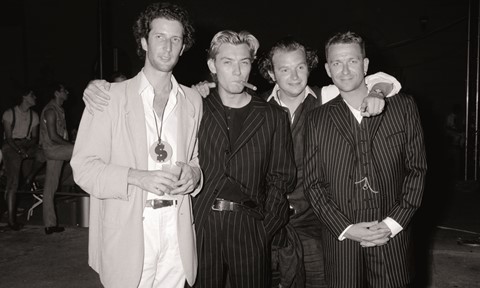
ralph ineson, Jude Law and sean pertwee
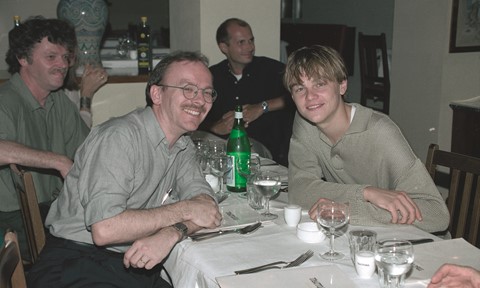
Leonardo DiCaprio with Programmer Robert Fischer
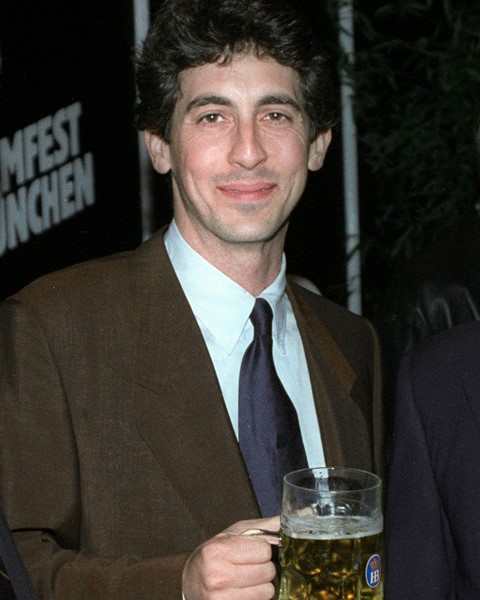
Cheers, Alexander Payne!
Although some of these names might not sound familiar today, the High Hopes section repeatedly brought filmmakers and actors to Munich who would later become well-known; these included Jude Law, the lead actor in Paul Anderson’s SHOPPING (Filmfest 1994). The most prominent guest from today’s perspective was certainly Leonardo DiCaprio, who starred in Scott Kalvert’s THE BASKETBALL DIARIES. Legend has it that at Filmfest 1995, DiCaprio stood around in the theater lobby, largely unnoticed.
The High Hopes section existed up to and including 1996 before it was discontinued. A year later, however, there was the High Hopes Award, sponsored by the Gesellschaft zur Wahrnehmung von Film- und Fernsehrechten (GWFF). Initially endowed with DM 50,000, the award was given to the producers of the best newcomer or debut film in the International Program. The first to receive it, in 1997, was the comedy CITIZEN RUTH; director Alexander Payne came to present the film. Eighteen years and two Oscars for best screenplay later, Payne was honored at Filmfest 2015 in a retrospective at the Filmmuseum, for which he returned to Munich.
MOVIES ABOUT MOVIES, OPEN-AIR MOVIES, KINKY MOVIES
One section that recurred both during and after Eberhard Hauff’s tenure was Lights, Camera, Action! This section showcased new works about cinema itself, focusing on well-known films and filmmakers, striking aesthetics, and iconographic locations. For example, under the less than catchy title PICTURE THIS: THE TIMES OF PETER BOGDANOVICH IN ARCHER CITY, TEXAS (Filmfest 1993), George Hickenlooper explored Bogdanovich’s THE LAST PICTURE SHOW and its sequel, TEXASVILLE, shot 20 years later.
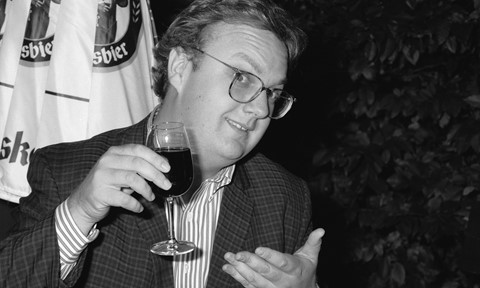
And cheers to you, George Hickenlooper!
Every year, a nightly program of open-air cinema was held at the Gasteig Forum — that is, in the courtyard of the Gasteig — with the screen hung high above the viewers. In 1993, for example, the Filmfest, in cooperation with Lufthansa’s arts fund, showed “Heavenly Cinema – Films about Flying”, which included such works as Billy Wilder’s THE SPIRIT OF ST. LOUIS and Kurt Hoffmann’s QUAX, DER BRUCHPILOT. In 1995, “German Films from 1945” were screened; in 1997 it was films by young German directors, from ABGESCHMINKT to MÄNNERPENSION. In 1999, the focus was on films by Roland Emmerich, and in 2000, on movies about dancing, from the 1970s (SATURDAY NIGHT FEVER) to the 1990s (STRICTLY BALLROOM).
“Welcome to the realm of horror, sex, and exploitation, to the world of exquisite abomination, of decadent erotica, of gaudy pulp fiction. Whoever watches these films will be venturing into treacherous terrain beyond the boundary of what is considered good taste.”
These words introduced the catalogue text for the Off Limits section inaugurated in 1996. Inspired by the “Midnight Movies” sections at other festivals, with an appetite for the “cinema of the bizarre”, 15 films were screened, including Buddy Giovinazzo’s COMBAT SHOCK, Roger Vadim’s LA JEUNE FILLE ASSASSINÉE, Dario Argento’s LA SINDROME DI STENDHAL, and Seijun Suzuki’s GATE OF FLESH. However, this section in which boundaries were pushed was not granted a long life. After one year, it was discontinued.
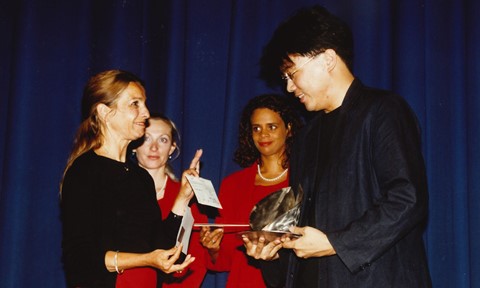
Bong Joon-ho receives the High Hopes Award.
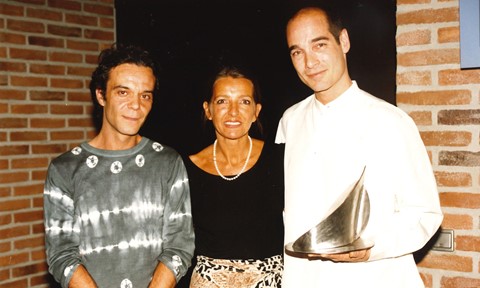
Jean-Marc Barr with producer Pascal Arnold and gertraud müller-ernstberger.
GEOGRAPHIC FOCUSES
Time and again, the Filmfest has focused on the cinema of specific countries and continents, from the retrospective of fifth-generation Chinese cinema mentioned above (Filmfest 1993) to a “Focus on British Cinema” (Filmfest 1998) that included Iain Softley’s adaptation of the Henry James novel THE WINGS OF THE DOVE, to a special on “Young Asian Cinema” (Filmfest 2001) that included BARKING DOGS NEVER BITE by Bong Joon-ho. That film received the High Hopes Award (for producer Min-hwan Cho). Bong Joon-ho returned to Munich in 2010 with MOTHER, and in 2019 for a retrospective that included his latest film, PARASITE, which by that time had earned the Palme d’Or at Cannes and later went on to earn four Oscars, including being the first foreign-language production in history to receive an Oscar for best picture.
French cinema was always a major part of the Filmfest. In 1996 it was given its own section, initially called “Young French Cinema”; later the title “Nouveau Cinéma Français” prevailed for a time. Over the years, this section was mainly curated by Robert Fischer; invited guests have included Jean-Marc Barr, star of THE BIG BLUE, whose directorial debut, LOVERS, was screened at Filmfest 1999 and for which he received the High Hopes Award along with co-author and co-producer Pascal Arnold.
Starting in 1999, a separate section was dedicated to Latin American cinema: Visiones Latinoamericanas. The films covered a range “from Mexico to Tierra del Fuego”, as stated in the 2001 catalogue, which included an article by Florian Borchmeyer, who would later curate the section. “‘Not another movie with old men who can fly’ is the typical reply you get, even from film buffs, when you suggest they see a movie from Argentina, Cuba, or Mexico,” he wrote.
While the magical realism of the “flying grandpas” in some of the films continued to be a recurring element, the section also admirably reflected an awakening that was occurring in Latin American cinema: for example, by screening LA CIÉNAGA by young Argentinian director Lucrecia Martel in 2001, to whom a wide-ranging homage was dedicated many years later at Filmfest 2018.
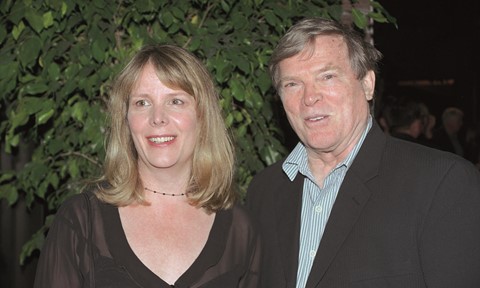
Chris Hegedus and D. A. Pennebaker
The American Independents section curated by Ulla Rapp continued to be popular and occasionally included specials. In 1995, one such special focused on films by and about B-movie director Ed Wood and on the first steps (“How They Began”) taken by later Hollywood greats such as Steven Spielberg; for example, screening his short film AMBLIN’ from 1968. (The title of this film explains the name of his Amblin Production Company, founded in 1969 — later Amblin Entertainment and Amblin Partners.) In 1994, the indie section featured THE WAR ROOM by Chris Hegedus and D. A. Pennebaker; in 2002, a homage was dedicated to the famous documentary duo.
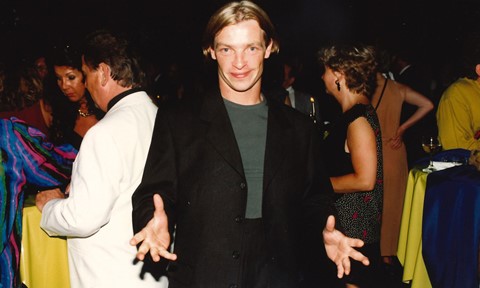
André Eisermann, main actor in Peter Sehr's SCHLAFES BRUDER.
NEw german FILMs
While the American Independents had found a home in the Filmmuseum, the films in the New German-Language Cinema section were screened at the Rio-Filmpalast. This would change in 1994, when both sections moved to the new festival center: the MaxX multiplex at the Isartor.
“MaxX certainly has one great advantage: the different-sized cinemas allow one to have a more diverse kind of programming. The beloved Rio was often simply too big for many small films. And there are, of course, plenty of small films in the German-language program. Often, they are the most interesting: newcomer films, debuts, breaking taboos, garish flights of fancy, films on burning social issues, new narrative forms, risks. One must make more small-scale, gritty films, Alexander Kluge once said. That was years ago. But I think it’s still valid.”
Ulrich Maass, curator of the German films, in the 1994 catalogue
Even the titles of some of the films in this section raised the expectation that they would be diamonds in the rough. Dagmar Wagner’s graduation film for the University of Television and Film Munich (HFF), which premiered at Filmfest 1993, for example, was a “staged documentary” with the charming title THE EGG IS A DIVINE EXCREMENT. While this film may have faded into obscurity somewhat, several other works in this section now number among the classics of German film. These include SCHLAFES BRUDER by Peter Sehr (also 1994), JENSEITS DER STILLE by Caroline Link (1996), BANDITS by Katja von Garnier (1997), and BANG BOOM BANG by Peter Torwarth (1999).
1998 marked the tenth anniversary of the Hypo-Bank’s Director’s Award. Previously, this award had gone to films by Dani Levy (WITHOUT ME, 1993), Rainer Kaufmann (STADTGESPRÄCH, 1995), and Oscar Roehler (SILVESTER COUNTDOWN, 1997); in the anniversary year, it went to two films, Hans-Christian Schmid’s 23 and Eoin Moore’s PLUS-MINUS NULL. In the years that followed, Peter Torwarth won for BANG BOOM BANG and Maren-Kea Freese for ZOE (1999), Vanessa Jopp for VERGISS AMERIKA (2000) and Benjamin Quabeck for NICHTS BEREUEN (2001). The year after that, the prize mutated into the German Cinema New Talent Award, sponsored by Hypo-Vereinsbank, Bavaria Film, and Bayerischer Rundfunk and presented in three categories: directing, screenplay and acting. In the first year, SOPHIIIIE! won twice (Michael Hofmann for directing and Katharina Schüttler for acting), writer-director Chris Kraus received the screenplay award for SCHERBENTANZ, and Detlef Bothe was awarded a Special Jury Award for FEIERTAG.
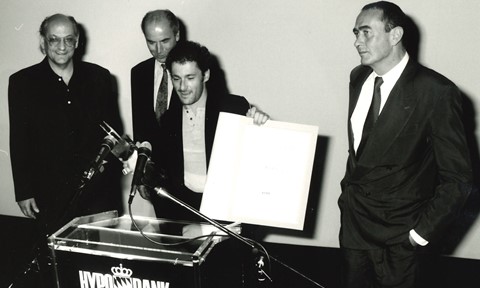
Dani Levy and bernd eichinger
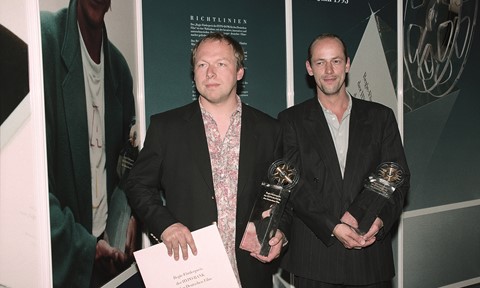
Rainer Kaufmann
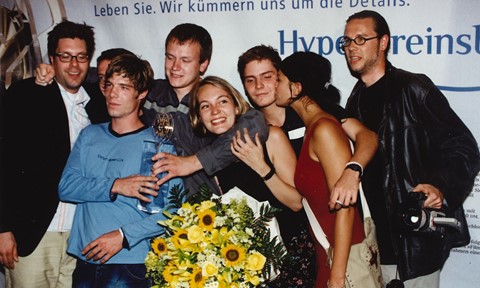
Benjamin Quabeck and the team of nichts bereuen
A distinction between the media is hard to maintain given the fact that television has become the most important medium of film reception for millions of people who were never in a cinema or for whom cinema no longer exists. And there is also the fact that television is, increasingly, creating its own films. FILMFEST MÜNCHEN ... will be giving more space to television in the future.
THE TELEVISION SECTION
When it introduced the Top Television section, the Filmfest became one of the first cinema festivals to bring TV movies to the big screen as German premieres. Initially, the focus was not on domestic productions. In the inaugural year 1994, entries from Germany, Canada, Japan, Cuba, Britain, Italy, and France were screened (including UN PULL PAR DESSUS L’AUTRE by Caroline Huppert, the sister of Isabelle Huppert). In 1996, the VFF TV Movie Award (later the Bernd Burgemeister TV Production Award), sponsored by the Verwertungsgesellschaft der Film- und Fernsehproduzenten, was presented for the first time to the best German and international TV movie, respectively. A total of 34 German and international entries were in competition; a year later, there were 42 entries from eleven countries.
As a result of this, the number of motion pictures was reduced, from 28 films from eight countries (Filmfest 1998) to 19 films from six countries (Filmfest 1999), prior to the TV section being split into a set of 13 TV movies “Made in Germany” and 12 “International TV Movies” in 2000. Starting in 2001, the festival focused entirely on domestic television productions, with the section being curated by Gabriele Gillner.
From 17 German TV entries at Filmfest 2001, the selection grew to a staggering 41 entries the following year, including individual episodes of crime thrillers with Commissioners Bloch (Dieter Pfaff) and Brunetti (Joachim Król) and Detective Dr. Eva Maria Prohacek (Senta Berger) in a section called “Suspected”. Oliver Hirschbiegel’s MEIN LETZTER FILM, starring the brilliant Hannelore Elsner, was given an official theatrical release in November of the same year after its premiere at the Filmfest.
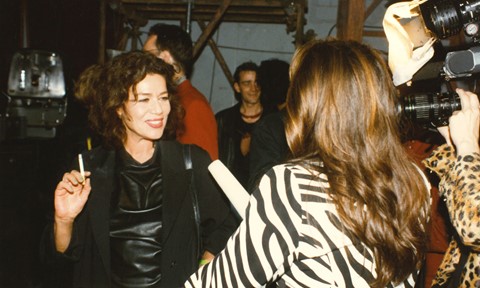
Hannelore Elsner in an Interview jungle.
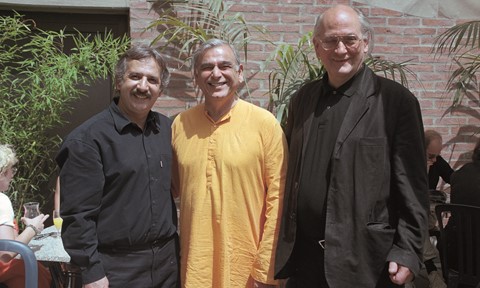
Majid Majidi, Ismail merchant and Reinhard Hauff
RETROSPECTIVES AT THE KINDERFILMFEST
In 1993, at the same time as the Filmfest special focused on the “fifth generation”, the Kinderfilmfest also looked to China, screening five films produced in the People’s Republic between 1989 and 1992. This was followed in 1994 by a short retrospective of children’s films from Turkmenistan.
Czech filmmakers have repeatedly been honored in retrospectives. In 1995 it was Karel Kachyňa (LONG LIVE THE REPUBLIC), in 1996 Johannes Hempel and in 1999 Karel Zeman, the latter two being regarded as pioneers of Czech animated puppet film. In 2001, Václav Vorlíček brought his new fairy tale film THOMAS AND THE FALCON KING and others to Munich. Previously, at Filmfest 2000, one focus of the Kinderfilmfest was on the works of Iranian director Majid Majidi (the CHILDREN OF HEAVEN), and in 2001 on the film adaptations of children’s books by Swedish author Ulf Stark.
In 1998, the special selection “Saying Goodbye and Being Sad” presented films for children which dealt with death and mourning with great sensitivity. These included PONETTE by Jacques Doillon and GEVATTER TOD by Wolfgang Hübner. In the catalogue, Hans Strobel wrote, “These films are just as much about life as they are about the strength and creativity of children. This special program can also be understood as an appeal to adults to have more confidence in children.”
Amid all this seriousness and depth, the Kinderfilmfest of course offered a cheerful time at the cinema as well. The audience of the young and young at heart reveled in anarchic delight at the goblin Pumuckl, whom director Peter Weissflog put on the big screen to mark the character’s 40th birthday. Hans Clarin, the incomparable voice of Pumuckl, attended the premiere of PUMUCKL UND SEIN ZIRKUSABENTEUER in the Carl-Orff-Saal at Kinderfilmfest 2002.
